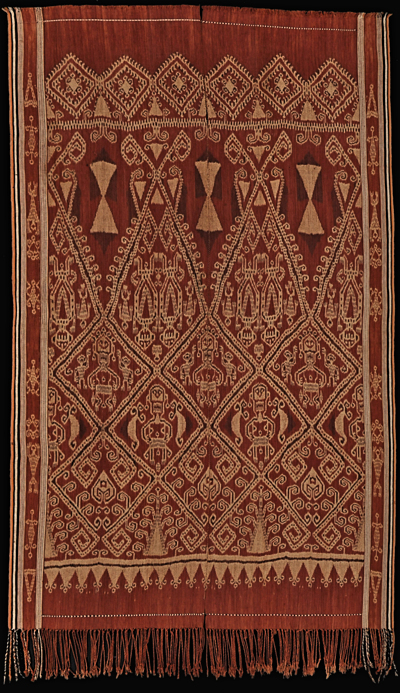| |
158 Borneo, Kalimantan
Pua kumbu
|
| Locale: | Mualang |
| Period: | 1920-1940 |
| Yarn: | Cotton, hand-spun, medium |
| Technique: | Warp ikat |
| Panels: | 2 |
| Size: | 109 x 188 cm (3' 6" x 6' 2") LW: 1.72 |
| Weight: | 780 g (27.5 oz), 381 g/m2 (1.25 oz/ft2) |
| Design: | Lozenges created by zig-zagging patterns in oppposition enclose anthropomorphic and zoomorphic figures. To quote Drake (see below): 'a dream-envisioned pattern of creatures inside the basic lozenge motif'. The zig-zag patterns may well represent the ubiquitous nabau, snake, which are often depicted in a similar manner. The changeover from regular diamonds to diamonds with a stretched lower part, here flaring open at the bottom, is seen also in the Mualang skirt referenced below. Between the elongated lozenges are three open spaces marked with a diabolo-shaped motif in stark white. Similar white markers among the Iban usually stand for trophy heads. The borders have been decorated with what appear to be crocodilian motifs. |
| Comment: | [While the large open, unadorned spaces might suggest the work of a novice, the opposite is true: this is the work of a master weaver. Novices leave spaces between their coils but only masters enjoy the liberty to leave large spaces between their motifs, and express their creativity - which is particularly valued among the Mualang. The drawing has been created by means of a three-fold repeat per panel of the basic ikated motif. The number three is particularly holy to the Mualang. Strong, saturated natural colours in both field and borders. The brittleness of the fibre (see micro photos) is compatible with the early dating. From old Dutch collection. |
| Background: | Chapters on Borneo and Kalimantan. |
| Sources: | Similar style elements seen on Mualang skirt depicted in Drake's oft-cited article Ibanic Textile Weaving, Fig. 10, unfortunately the only primary source on Mualang ikat. |
| |

©Peter ten Hoopen, 2024
All rights reserved.
|


